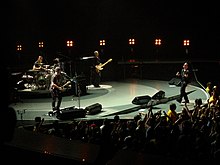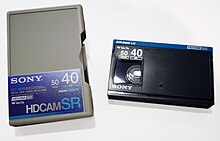U2 3D
Directed by Catherine Owens and Mark Pellington, the film contains performances of 14 songs, including tracks from How to Dismantle an Atomic Bomb (2004), the album that the tour supported.
[4] In 2001, producers Jon and Peter Shapiro created a 2D IMAX concert film titled All Access, which featured live performances of several musicians.
[12] The Modells' collaboration with U2 for the film was facilitated by their involvement with the band in researching LED display technology in 1997 for use at Ravens Stadium at Camden Yards.
[18] Pre-production for U2 3D officially started in early 2004,[19] and the production was handled by 3ality Digital, a company formed from Schklair's Colbalt Entertainment and his partnership with the Modells and the Shapiros.
[6] Midway through the year, Bono agreed to let the 3ality Digital crew record test footage, which was accomplished using a single 3D camera at one of U2's Vertigo Tour concerts in Anaheim, California in March 2005.
[20] The producers originally wanted to shoot in Los Angeles where all the filming equipment was located,[10] but Owens and the band decided they needed a more enthusiastic audience.
[21] U2 ultimately chose to film in five cities in Latin America from February to March 2006, believing their absence from the region for eight years would foster an energetic atmosphere.
[10][24] The crew had two days to set up the filming equipment before each concert, which required running fiber-optic cables and hooking up an electrical generator to supply power at each venue.
To avoid capturing other camera rigs in the footage, the crew would either film from the back of the stage, or alternate each night between shooting left-to-right and right-to-left.
[36] Principal photography began in February 2006, under the supervision of the 3D cinematographer Peter Anderson; two shows were filmed in Mexico City with two camera rigs to capture medium shots during a practice run for the crew to learn the choreography of U2's performances.
[8]: 4 During preparations for the Buenos Aires concerts, U2 performed a 10-song set without an audience, so that the crew could capture close-up footage using a wide-angle lens; doing so in-concert would have interfered with the show.
[8]: 4 In March 2006, the remaining Vertigo Tour concerts were postponed when the daughter of guitarist The Edge fell ill.[38] During the interim, footage from the seven filmed shows was edited together, prompting the crew to request additional wide shots from the back of the stadium and close-ups of the band members.
[31] Post-production on U2 3D was led by editor Olivier Wicki who worked closely with Owens throughout the process; the two had previously collaborated on the "Original of the Species" music video.
[39] To appeal to a mainstream audience, 14 tracks were chosen for the film, including 12 of U2's singles and two non-singles from How to Dismantle an Atomic Bomb, the album that the Vertigo Tour supported.
[39] Owens stated that the main focus of the film was based upon U2's relationship with one another and with their audience, and the challenge of selecting the songs was to create a narrative within the band's performance.
Other tracks that were performed at most of the filmed concerts that did not make the final cut include "Elevation", "I Still Haven't Found What I'm Looking For", "Original of the Species", and "Zoo Station".
[33][48] Left-eye and right-eye footage was assembled on separate layers, then edited together with color grading added, and eventually output in a 3D stereoscopic format for review.
[19] Glanville and Adams said the audio editing was difficult mainly because the selection of video footage was limited, as only one to two cameras angles were captured at most of the shows.
The sound from the subwoofer channel was mixed inside two IMAX theaters in Los Angeles to ensure the volume of low-end frequencies was consistent with the rest of the soundtrack.
[40] Clips from the "Vertigo" and "The Fly" performances were featured in the trailer, which was edited by creative director John Leamy, who also designed the logo and title sequence for U2 3D.
[57] National Geographic chose Best Buy as the film's American sponsor, and offered passes to select members of the retailer's loyalty program to view U2 3D before its wide release.
[58] U2 3D was promoted through the internet, print, radio, television,[32][59] on a JumboTron in Times Square,[60] and as a sponsor on NASCAR's #19 Best Buy Dodge stock car driven by Elliott Sadler.
[46][68] The venue incorporated a customized sound system designed especially for the premiere with new Dolby 3D technology,[69] which John Modell referred to as "the most high tech film screening that's ever been done in history.
[63][97] Critics from publications such as the Irish Independent,[98] The New Zealand Herald,[99] Reno News & Review,[4] Toronto Star,[97] and USA Today[100] said that the film's 3D experience was "even better than the real thing"—a reference to U2's song of the same name.
[103] The New York Times designated U2 3D as a "Critics' Pick" and stated in the review that the film was "the first IMAX movie that deserves to be called a work of art".
[104] U2 3D appeared on many critics' lists of the top 10 films released in 2008 including The Austin Chronicle,[105] OhmyNews International,[106] Seattle Post-Intelligencer,[107] The Sydney Morning Herald,[108] and River Cities' Reader.
[122][123] In 2019, film critic Matt Zoller Seitz referred to U2 3D as one of "the two best modern 3D movies" and praised how it used "technology to expand the aesthetic vocabulary of cinema".
[42] The extensive use of technology during production was featured as the cover story in the December 2007 issue of the high-definition video magazine HDVideoPro, a month before the premiere of U2 3D.
[21] Its usage of evolutionary technology led to Catherine Owens being selected as a featured guest speaker at the SIGGRAPH 2008 conference, which took place several months after the film's release.
[126] After U2 3D received praise from fans, critics, and the film industry, several of the filmmakers stated that they felt it helped create a paradigm shift in cinema history, due to the technological advancements used in the production.






